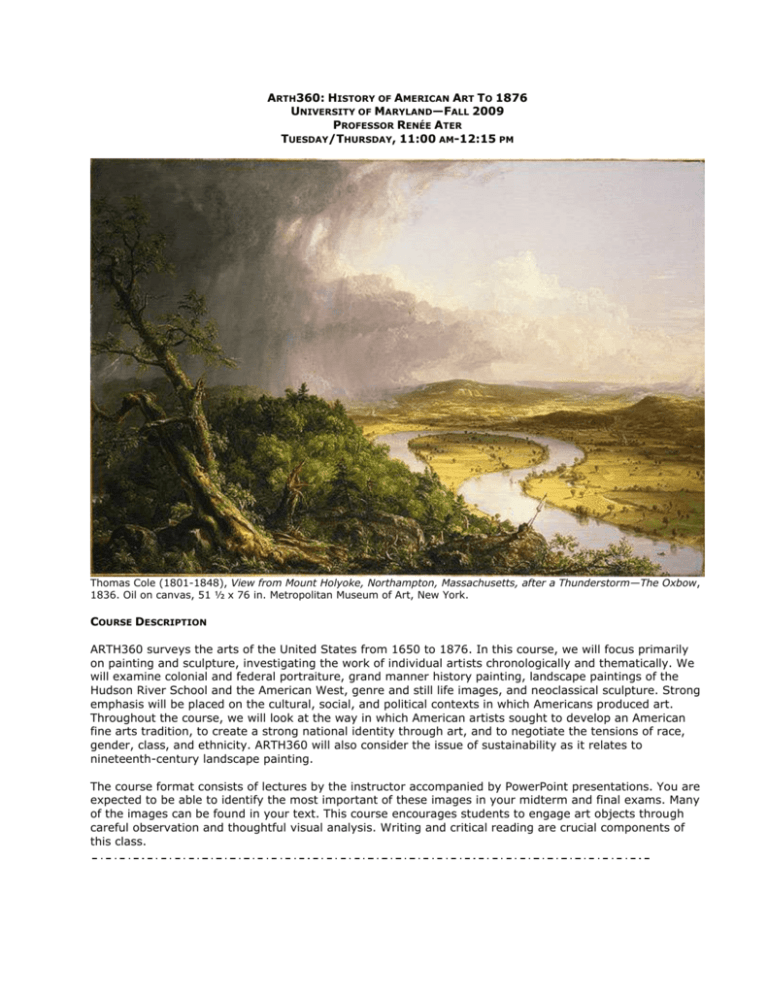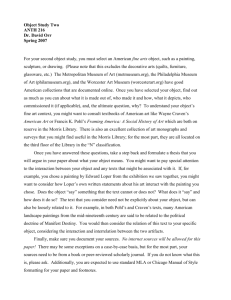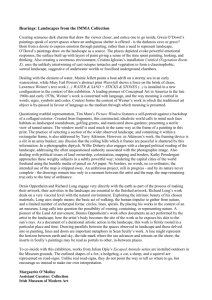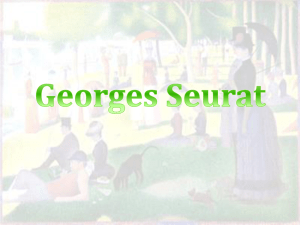
ARTH360: HISTORY OF AMERICAN ART TO 1876
UNIVERSITY OF MARYLAND—FALL 2009
PROFESSOR RENÉE ATER
TUESDAY/THURSDAY, 11:00 AM-12:15 PM
Thomas Cole (1801-1848), View from Mount Holyoke, Northampton, Massachusetts, after a Thunderstorm—The Oxbow,
1836. Oil on canvas, 51 ½ x 76 in. Metropolitan Museum of Art, New York.
COURSE DESCRIPTION
ARTH360 surveys the arts of the United States from 1650 to 1876. In this course, we will focus primarily
on painting and sculpture, investigating the work of individual artists chronologically and thematically. We
will examine colonial and federal portraiture, grand manner history painting, landscape paintings of the
Hudson River School and the American West, genre and still life images, and neoclassical sculpture. Strong
emphasis will be placed on the cultural, social, and political contexts in which Americans produced art.
Throughout the course, we will look at the way in which American artists sought to develop an American
fine arts tradition, to create a strong national identity through art, and to negotiate the tensions of race,
gender, class, and ethnicity. ARTH360 will also consider the issue of sustainability as it relates to
nineteenth-century landscape painting.
The course format consists of lectures by the instructor accompanied by PowerPoint presentations. You are
expected to be able to identify the most important of these images in your midterm and final exams. Many
of the images can be found in your text. This course encourages students to engage art objects through
careful observation and thoughtful visual analysis. Writing and critical reading are crucial components of
this class.
Professor Renée Ater
DRAFT: ARTH360-Fall 2009
page 2
COURSE OBJECTIVES
Become familiar with a range of American artists working in the eighteenth and nineteenth
centuries.
Refine skills in visual analysis in relation to the arts of the United States.
Investigate the issue of national identity as it relates to the arts of the United States.
Demonstrate the dependence of meaning upon cultural, social, and political contexts when
analyzing American art.
Consider the issue of sustainability as it relates to American art, particularly landscape painting
of the nineteenth century.
Communicate effectively through written and oral communication.
OFFICE LOCATION
My office is located in the Art/Sociology Building on the 4th floor, Room 4216.
EMAIL AND TELEPHONE
You can email me at rater@umd.edu or leave a message on my office telephone at 301-405-1490. I will
respond to emails Monday-Friday, from 9:00 am–5:00 pm.
OFFICE HOURS
My office hours are on Tuesdays from 1:00-3:00 pm and by appointment.
REQUIRED BOOKS
There are three required books for this course. They are available at the University Book Center and the
Maryland Book Exchange.
1. Frances K. Pohl, Framing America: A Social History of American Art, Second Edition, Thames & Hudson,
2008. ISBN 978-0-5-0028715-6
2. Marianne Doezema and Elizabeth Milroy, eds., Reading American Art, Yale University Press, 1998.
ISBN 978-0-3-0006998-3
3. Sylvan Barnet, A Short Guide to Writing About Art, 9th edition, Pearson/Prentice Hall, 2008.
ISBN 978-0-1-3613855-6
RESERVE READING
Additional readings for ARTH360 are on reserve in the Art Library and available through the electronic
database JSTOR, which is accessible through ResearchPort in the UMD Library Catalog. Reserve readings
are indicated by the letters RSRV or JSTOR in parenthesis in the course outline section of this syllabus.
I also have placed several books on reserve in the Art Library that will assist you in writing your paper on
sustainability and nineteenth-century landscape painting. You can access the course reserve list through
ELMS/Blackboard.
ELMS/BLACKBOARD
All course information including syllabus, research paper guidelines, and research tips can be found on
ELMS/Blackboard. I will post announcements to Blackboard; be sure to check the course site once a week.
Go to http://elms.umd.edu and log in using your UMD ID and password. Select “ARTH 360” to access the
course site. Please familiarize yourself with this communication system and make sure your e-mail address
is updated in Testudo (http://testudo.umd.edu).
Professor Renée Ater
DRAFT: ARTH360-Fall 2009
page 3
COURSE REQUIREMENTS
A. READINGS
All readings for the course are to be done weekly. You are expected to read all of the material for this
course.
B. RESEARCH PAPER
You are required to write a research paper (8 pages) based on the issue of sustainability and a single
landscape painting in the collection of the National Museum of American Art or the National Gallery of Art.
You must select a work of art that is CURRENTLY on display. Please see page 9 of this syllabus for a
description of the assignment. All papers must be typed and double-spaced, 1-inch margins, 12-point font
(Times New Roman), standard page size (8 1/2 x 11). The paper is due in class on November 19.
C. LATE PAPERS
I do not accept electronic copies of papers or emailed papers. Late papers result in a loss of five (5) points
per day—including Saturday and Sunday.
D. EXAMS
There will be a midterm exam and a final exam for this course. Both exams are comprised of four to five
essay questions. For each essay question, you will be shown two slides. You will be asked to identify each
image by artist, title, and year and then to compare the images in the light of the question posed. You
should bring in the readings from the course text in your answers to demonstrate your hard work and firm
grasp of the subject matter. The midterm will be on October 15; the final will be on Monday, December
14, at 8:00 am-10:00 am. The exams are not cumulative.
Make-up exams will be scheduled if there are compelling circumstances beyond the student’s control (for
example: illness, religious observance, car accident, death in the family). You must provide appropriate
documentation (doctor’s note, police report, etc) in order to take a make-up exam. Be advised that only
one make-up exam will be scheduled within a week of the missed exam.
For additional information on university policy regarding attendance and assessment/examinations, please
see the online Undergraduate Catalog 2008-2009:
www.umd.edu/catalog/index.cfm/show/content.section/c/27/ss/1584/s/1540
E. ATTENDANCE AND CLASS PARTICIPATION
Attendance and active participation in class sessions are essential. This involves assuming the
responsibility to speak thoughtfully and listen attentively. Such participation is, of course, only possible
when you have done the week’s reading and are present in class. Class participation also includes group
discussions and in-class writing assignments. Please notify me in advance if you must be absent from
class.
COURSE GRADING
REQUIREMENTS
WEIGHT
DUE DATE
Midterm Exam
30%
October 15
Final Exam
30%
December 14
Research Paper
30%
November 19
Participation in class discussion based on
readings, images, and lectures
10%
Determined at end
of semester
Professor Renée Ater
DRAFT: ARTH360-Fall 2009
page 4
UNIVERSITY POLICY
A. ACADEMIC INTEGRITY
The University of Maryland, College Park has a nationally recognized Code of Academic Integrity,
administered by the Student Honor Council. This Code sets standards for academic integrity at Maryland
for all undergraduate and graduate students. As a student you are responsible for upholding these
standards for this course. It is very important for you to be aware of the consequences of cheating,
fabrication, facilitation, and plagiarism. For additional information on the Code of Academic Integrity visit
the Student Honor Council web site: http://www.shc.umd.edu.
To further exhibit your commitment to academic integrity, remember to sign the Honor Pledge on all
examinations and assignments: "I pledge on my honor that I have not given or received any unauthorized
assistance on this examination (assignment)."
B. ACADEMIC ACCOMMODATIONS FOR STUDENTS WITH DISABILITIES
If a student has a documented disability and wishes to discuss academic accommodations, please contact
the professor as soon as possible. The rules for eligibility and the types of accommodations a student may
request can be reviewed on the Disability Support Services web site:
http://www.counseling.umd.edu/DSS/receiving_serv.html.
Disability Support Services requires that students request an Accommodation Form each semester. It is the
student's responsibility to present the form to the professor as proof of eligibility for accommodations.
C. RELIGIOUS OBSERVANCES
The University System of Maryland policy states that students should not be penalized in any way for
participation in religious observances. Students shall be allowed, whenever practicable, to make up
academic assignments that are missed due to such absences. It is the student's responsibility to contact
the professor, and make arrangements for make-up work or examinations. The student is responsible for
providing written notification to the professor within the first two weeks of the semester. The notification
must identify the religious holiday(s) and date(s). For additional information on religious observances visit
the University of Maryland Policies and Procedures website:
http://www.president.umd.edu/policies/iii510a.html.
Professor Renée Ater
DRAFT: ARTH360-Fall 2009
page 5
COURSE SYLLABUS
1
September 1
Introduction to Course
September 3
Images of the New World
WEEK
Required reading
Pohl, Framing America, pp. 15-62
2
September 8
Display of Status: 17th-Century Portraiture
September 10
Depictions of the Merchant Class: Early 18th-Century Portraiture
WEEK
Required reading
Pohl, Framing America, pp. 62-74
Wayne Craven, “The Seventeenth Century New England Mercantile Image: Social
Content and Style in the Freake Portraits,” pp. 1-11 in Reading American Art
3
September 15
The “New” American: 18th-Century Portraiture after 1750
September 17
Case Study: John Singleton Copley and the Portrait of Materiality
WEEK
Required reading
Pohl, Framing America, pp. 82-86 and pp. 131-135
Paul Staiti, “Character and Class: The Portraits of John Singleton Copley,” pp. 1237 in Reading American Art
4
September 22
Case Study: Charles Wilson Peale and the Cultural Document
September 24
Imagining George Washington
WEEK
Required reading
Pohl, Framing America, pp. 91-100
Roger B. Stein, “Charles Willson Peale’s Expressive Design: The Artist in His
Museum,” pp. 38-78 in Reading American Art
5
September 29
Death and Remembrance: Colonial Gravestones
October 1
Furniture, Figureheads, Fountains: Early American Sculpture
WEEK
Required reading
Wayne Craven, “The Origins of Sculpture in America: Philadelphia, 1785-1830,”
American Art Journal, vol. 9, no. 2 (November 1977): 4-33. (JSTOR)
Professor Renée Ater
DRAFT: ARTH360-Fall 2009
page 6
WEEK 6
October 6
Contemporary American History: Grand Manner History Painting, 1785-1830
October 8
European Precedents: Grand Manner History Painting, 1785-1830
Required reading
Pohl, Framing America, pp. 74-78, pp. 86-90, pp. 116-125
Jules Prown, “Benjamin West and the Use of Antiquity,” American Art, vol. 10, no.
2 (Summer 1996): 29-49 (JSTOR)
7
October 13
Illusion and Allusion: Still Life Painting, 1785-1830
October 15
MIDTERM EXAM
WEEK
Required reading
Alexander Nemerov, The Body of Raphaelle Peale: Still Life and Selfhood, 1812-24
(University of California Press, 2001), pp. 83-100 (RSRV)
8
October 20
Introduction to Major Themes in American Landscape Painting
October 22
Introduction to Major Themes in American Landscape Painting
WEEK
Required reading
Albert Boime, The Magisterial Gaze: Manifest Destiny and the American Landscape
Painting, c. 1830-1865 (Smithsonian Institution Press, 1991)
Angela Miller, The Empire of the Eye: Landscape Representation and American
Cultural Politics, 1825-1875 (Cornell University Press, 1993)
Rebecca Bedell, The Anatomy of Nature: Geology and American Landscape
Painting, 1825-1875 (Princeton University Press, 2001)
Andrew Wilton and Tim Barringer, American Sublime: Landscape Painting in the
United States, 1820-1880 (Princeton University Press, 2003)
9
October 27
Case Study: Thomas Cole and the Moralizing Landscape
October 29
Hudson River School, Manifest Destiny and the Romantic Landscape
WEEK
Required reading
Pohl, Framing America, pp. 138-153
Alan Wallach, “Thomas Cole and the Aristocracy,” pp. 79-108
in Reading American Art
Professor Renée Ater
DRAFT: ARTH360-Fall 2009
page 7
10
November 3
Hudson River School, Manifest Destiny and the Romantic Landscape
November 5
Case Study: Frederic E. Church and the Natural World
WEEK
Required reading
Pohl, Framing America, pp. 156-160 and pp. 173-176
Franklin Kelly, Frederic Edwin Church and The National Landscape (Smithsonian
Institution Press, 1988)
11
November 10
Case Study: Albert Bierstadt and the Western Landscape
November 12
Luminism: American Light and the Landscape
WEEK
Required reading
Pohl, Framing America, pp. 160-173
Nancy Anderson, “’The Kiss of Enterprise’”: The Western Landscape as Symbol and
Resource,” pp. 208-231 in Reading American Art
12
November 17
American Genre Painting: Scenes of Everyday Life
November 19
Case Study: William Sidney Mount and the Politics of Representation
WEEK
Required reading
Pohl, Framing America, pp. 176-184, pp. 198-203, and pp. 209-223
William T. Oedel and Todd S. Gernes, “The Painter’s Triumph: William Sidney
Mount and the Formation of a Middle-Class Art,” pp. 128-149 in Reading American
Art
PAPER ASSIGNMENT DUE
13
November 24
No Class
November 26
THANKSGIVING
14
December 1
White Bodies and White Marble: Neoclassical Sculpture, 1825-1870
December 3
Case Study: Hiram Powers and the Challenge of Nudity
WEEK
WEEK
Required reading
Pohl, Framing America, pp. 272-274
Joy Kasson, “Narratives of the Female Body: The Greek Slave,” pp. 163-189 in
Reading American Art
Professor Renée Ater
DRAFT: ARTH360-Fall 2009
15
December 8
Case Study: Edmonia Lewis and the Racialized Body
December 10
Philadelphia Centennial Exposition, 1876
page 8
WEEK
Required reading
Pohl, Framing America, pp. 229-236 and 254-259
Kirsten Buick, “The Ideal Works of Edmonia Lewis: Invoking and Inverting
Autobiography,” pp. 190-207 in Reading American Art
LAST DAY OF CLASSES
December 14
FINAL EXAM
Monday, 8:00—10:00 am
Professor Renée Ater
DRAFT: ARTH360-Fall 2009
page 9
ARTH360: HISTORY OF AMERICAN ART TO 1876
RESEARCH PAPER GUIDELINES
SUSTAINABILITY, NATURE, AND THE HUDSON RIVER SCHOOL
Sustainability—the ability to provide for the needs of the current generation without compromising the
ability of future generations to meet their needs—is the challenge of the 21st century. As we move into the
future, we must consider how we utilize and consume resources if we are to avoid dramatic changes to the
environment and potential for the collapse of global ecosystems. This paper assignment asks you to
consider the notion of sustainability historically through nineteenth-century landscape painting—the
Hudson River School. How were artists of the 19th-century concerned or not concerned with the
environment and what we now call sustainability? In their painting, American artists considered the
significant changes to the land as the nation expanded it boundaries. As the landscape rapidly changed,
American landscape painters sought to record the “domestic paradise” for future generations. They
wrestled with the ways in which the human presence intruded on the natural world, seeing technological
advances as signs of progress and as signs of nature’s destruction. For example, the image of the railroad
was popular during this period, an emblem of growth and ruin. George Inness in The Lackawanna Valley
(1855), on the left, critiqued the transformation of the land while Jasper Cropsey in Starrucca Viaduct,
Pennsylvania (1865), on the right, embraced the rapid changes he saw, presenting man and nature as
existing in harmony.
TOPIC
You are to write an eight-page (8) paper based on a single work of art by an American landscape painter,
1835-1875. In this paper you will consider the issue of sustainability as a historical idea and the way in
which it relates to ideas of nature, culture, and progress in American art. You must select a work of art
from the permanent collection of the Smithsonian American Art Museum or the National Gallery of Art.
Use the following as a general map for writing your paper. (You will have other points to make and don’t
be afraid to introduce your own ideas.)
Provide brief biographical information about the artist.
Describe the context of the artist and his or her work—briefly describe the main concerns of the
Hudson River School
Write a visual analysis of the work of art--use Sylvan Barnet’s A Short Guide to Writing About Art.
Consider the cultural, social and political implications of the work. What is the work trying to
communicate?
Consider the issue of sustainability. What does the work say about the nature, culture, and
progress?
Discuss the controversies, if any, inherent in the work.
What is YOUR opinion of the work?
Professor Renée Ater
DRAFT: ARTH360-Fall 2009
page 10
MUSEUMS
National Gallery of Art, Washington, DC, or Smithsonian American Art Museum, Washington, DC,
Permanent Collection
READINGS
Below is a list of readings to assist you in writing your paper; they are on reserve in the art library. You
should, of course, use any of the readings from the syllabus. You must incorporate the writings of Emerson
and/or Thoreau into your paper.
Ralph Waldo Emerson, Nature (1836)
Henry David Thoreau, Walden, or Life in the Woods (1854)
Barbara Novak, Nature and Culture: American Landscape and Painting, 1828-1875, 3rd edition (Oxford
University Press, 2007)
Eleanor Jones Harvey, The Painted Sketch: American Impressions from Nature, 1830-1880 (Dallas Museum
of Art, 1998)
John K. Howat, American Paradise: The World of the Hudson River School (Metropolitan Museum of Art,
1987)
Richard J. Schneider, ed. Thoreau’s Sense of Place: Essays in American Environmental Writing (University
of Iowa Press, 2000)
Barbara Novak, Voyages of the Self: Pairs, Parallels, and Patterns in American Art and Literature (Oxford
University Press, 2007)
DUE DATE
Papers are due in class on Thursday, November 19, 2009. Late papers result in a loss of five (5) points
per day—including Saturday and Sunday. No exceptions. You have 10 weeks to finish this assignment—do
not wait until the last minute to
RESEARCH
This is a research paper. Find books and articles on your artist using the Art Library and McKeldin Library,
Interlibrary Loan, and electronic databases available through the UMD catalog such as Art Index
Retrospective, Art Abstracts, and ARTbibliographies Modern.
You may not use Wikipedia or the World Wide Web for research.
PAPER REQUIREMENTS
8 pages.
Double-spaced, 1-inch margins, and 12 point font (Times New Roman).
Footnotes and bibliography are required. You must have at least four sources: two scholarly
books (no encyclopedias) and two articles from art history journals.
A copy (black-and-white or color) of the image.
OFFICE OF SUSTAINABILITY
For additional information on sustainability and the University of Maryland, please visit the website:
http://www.sustainability.umd.edu/index.php
In May 2009, I participated in the Chesapeake Project: Integrating Sustainability Across the Curriculum.
The Chesapeake Project is “a learning community of University of Maryland faculty who are finding unique
ways of teaching about sustainability across the disciplines to prepare students to find solutions to the
world`s most challenging problems. The name of this initiative, the Chesapeake Project, represents two
ideas: (1) that the University of Maryland is joining a network of other colleges and universities that are
making strides to integrate sustainability through their own projects (ex. the Piedmont Project at Emory U.,
the Ponderosa Project at Northern Arizona U., etc.) and (2) that Maryland faculty will use ecological, social,
Professor Renée Ater
DRAFT: ARTH360-Fall 2009
page 11
and economic examples from around the Chesapeake region to help our students see the connection
between curriculum and place.”
For more information on the Chesapeake Project:
http://www.sustainability.umd.edu/index.php?p=chesapeake_project









